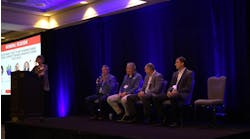The IndustryWeek Talent Advisory Board offers monthly advice on how its members got to where they are in the manufacturing world. If you have a question for the group, please send it to [email protected].
IndustryWeek’s Talent Advisory Board question for January was: The Talent Advisory Board is in part aimed at young manufacturing leaders interested in reading advice from leaders of industry. How do you cultivate leadership in your comparatively unexperienced employees?
Carlos Torres—Head of Industry 4.0 at USA 5G Smart Factory, Ericsson
A previous manager once told me, "We naturally make time to talk about projects. We need to prioritize time to talk about people.” For me and my leadership team, we cultivate leadership by creating a culture that is people-first, transparent, and authentic.
Organizations have existing processes and ways of working that have been developed over the years to maximize effective execution of projects. Steering groups, status meetings, roadmaps are all common day-to-day activities. One-on-one sessions can easily be hijacked for managers to receive project updates, set expectations, and discuss roadblocks. Setting recurring, consistent blocks of time to cultivate leadership by mentoring, coaching, and providing growth opportunities also need to become a day-to-day activity and not something that happens twice a year. For me and my leadership team, in addition to regular performance review discussions, we have implemented recurring monthly people sessions, quarterly stay interviews, skip levels, and Q&A sessions with the team.
It is important for leaders to gain the trust of employees by doing what we say we will do and explaining why we cannot when it isn’t possible. Transparency, sincerity, and authenticity are especially important for younger employees and key to creating future leaders.
Audrey Van de Castle—Director of Digital Transformation, Stanley Black & Decker
As a technology leader, I easily find opportunities for unexperienced employees to gain leadership experience via technology projects in our manufacturing sites. These projects are ideal for high-potential, unexperienced employees to lead and have as a ‘stretch’ project or goal. When we give employees the ownership of delivering results, they always shine. If you are a young manufacturing leader, look for these opportunities. Ask yourself “where can technology improve our operations?”
Seize the opportunity and show how you can help envision, strategize, drive and improve your site’s processes. These hands-on projects are the BEST way to learn and gain that leadership experience. When you are successful, your peers and managers will see those results and begin to rely on you for more leadership opportunities.
Bill Scilingo—Vice President of Operations, Penn Color Inc.
I have found the best approach to cultivating leadership in unexperienced employees is to immediately challenge those that have shown the attitude, work ethic, and desire to grow.
Currently, three main initiatives in our operations organization are being led by young team members. Allowing these individuals to take on these complex projects while supporting from afar will accelerate their exposure and growth. What I have found from them are these main tenets to cultivate leadership: support, positivity and challenge. Find a mentor who is engaged and willing to provide you with candid and supportive feedback regarding your performance, communication skills and situational awareness. Equally important is to find and associate yourself with positive team members. Although most organizations consist of a high percentage of motivated, positive individuals, all teams have those set in their ways individuals who, at times, are more concerned about highlighting obstacles as opposed to identifying means to circumvent and surpass these challenges. Identify with the progressive, team oriented and positive crowd. Challenge yourself to stretch your capabilities and step up when opportunities arise.
One of the most influential pieces of advice I received when starting in manufacturing was “If you see something that needs to be done, do it, as no one else is going to do it for you.” Although this may mean taking on some extra work and risk, you can’t grow as a leader until you establish yourself in challenging situations or project. With the correct mentorship, the correct coworker association, and an initiative-driven, positive attitude, your leadership growth will be accelerated.
Carl Livesay, General Manager—Mercury Plastics MD
When working with both new and existing team members identified as future candidates for leadership roles:
- Look at the person as an individual. This is not as simple as it sounds.
- Determine if the team member has interest in leadership. This is relatively easy to assess once you get to know the team member. Make certain they are willing to invest in themselves.
- Address the barriers to success. Personal situations vary greatly. There may be numerous obstacles in the path to success, most of which can be overcome with a patience and guidance.
- Look at the whole person. This will take time.
- Get to know the team member and develop an understanding of their personality and personal situation.
When you are convinced that you have a candidate, the training starts. We begin by coaching the team member. Assigning tasks which, over time, increase in complexity while decreasing in instruction. The goal is to help them experience the taste of success while building self-confidence and self-esteem. The coach continues to provide less instruction and guidance further helping the team member learn to analyze the situation, develop and execute the plan. All under the watchful eye of their coach. Bear in mind there will be failures. Coaching the team member through the failures is arguably some of the most valuable lessons to be learned. After all, it is said that anyone can steer the ship when the sea is calm.
Once the team member has experienced success and failure many times, the leader transitions from coach to mentor. Beginning with smaller projects, the goal or objective is described, and the team member is asked to analyze the situation and develop a plan to produce the desired results. Then they are asked to execute the plan while the mentor remains available to monitor progress and ask questions which will stimulate a positive response.
The salient difference between coaching and mentoring is that the coach has a solution determined and they assign tasks with specific actions in mind answering detailed “how to” questions as needed. A mentor describes the desired results, and the team member is responsible to find a solution. In both scenarios, there is an escalating degree of difficulty.
The only thing more rewarding than seeing your new leader succeed and become a leader is to see them pay it forward.
Paul Baldassari—Executive Vice President of Worldwide Operations, Flex
Leadership, like all capabilities, takes a combination of both learning and hands-on experience to strengthen your skillset. Aspiring leaders need opportunities to learn through training, feedback, and mentoring, as well as new and challenging on-the-job experiences that encourage growth, but aren’t overwhelming.
Timothy Noble, President & Managing Partner—The Avery Point Group, Inc.
As I have noted in some of my previous postings, I was very fortunate to be part of a corporate culture at GE during the Jack Welch era that focused heavily on leadership development. I took away many lessons from my own experience that I leveraged throughout my career with regard to talent development. It should be recognized that not all folks seek out or want to be put into leadership roles. However, those who have the initiative, communication skills, problem-solving ability, and a willingness to learn should be provided opportunities for growth within an organization as part of any talent development process. GE, during that era, invested heavily in providing training and development for its future leaders and my career certainly benefits from that investment.
Identifying talent as part of the annual employee review process is key. Once talent has been identified, it is critical to nurture and challenge that potential talent by offering leadership training programs, workshops, or seminars. It is also key to provide opportunities for them to participate in cross-functional projects or to take on roles that stretch their capabilities as part of a growth and talent retention plan. This was certainly the case in my career as an early executive band leader at GE. It is also critical that you pair potential talent with a mentor or coach who can provide them with very candid and honest feedback… not just celebrate their wins. Providing opportunities for young potential leaders to take on ownership of key projects and initiatives where they can grow in their confidence and ability is also key.
As manufacturing leaders, show them by example the principles of leadership standard work that includes problem-solving, Gemba walks, coaching, strategic planning, and reflective practices designed to create a consistent and effective leadership approach aligned with your organization's goals. Cultivate an environment where taking calculated risks is encouraged, and failure is viewed as a learning opportunity rather than a setback for punishment. One of my mentors stressed that being open to failure is more important to learning and growth versus never being challenged. Expose them to different parts of the business and encourage them to build a network. This could include attending industry conferences, internal networking events, or professional groups. As part of my leadership development program at GE, I had the opportunity to rotate between 4 different roles in 2 different business units. Finally, encourage them to reflect on their own leadership style, strengths, and areas for improvement. Personal development plans can be helpful tools in this process when they are paired with candid feedback.
In conclusion, I believe that in order to cultivate tomorrow's leadership, you need structured training with hands-on experience along with a culture that values continuous learning, mentorship, and feedback. In my experience, this approach effectively develops skilled leaders and fosters an environment that recognizes and grows potential, preparing a new generation of leaders for today's business challenges.




